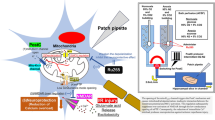Summary
We investigated the effect of lysophosphatidylcholine (lysoPtdCho) and palmitoylcarnitine (PamCar), ischemia-induced amphipathic lipid metabolites, on the inward rectifier K+ channel in guinea-pig ventricular cells, under whole-cell and cell-attached configurations with patch-clamp techniques. (a) Both lysoPtdCho (10–50 µM) and PamCar (10–50 µM) depolarized the resting membrane potential (RP), retarded the repolarization of action potential, provoked spontaneous action potential discharges from oscillatory afterpotentials, and eventually caused a sudden rise of the RP to plateau levels. (b) These lysoPtdCho- or PamCar-induced depolarizations of RP were due to a decrease in the inward rectifier K+ current (IK1), and the sudden rise of the RP could be accounted for by a crossover of N-shaped current-voltage relationship on the voltage axis (zero current line) more than once. (c) Single-channel studies in the cell-attached mode revealed that lysoPtdCho (5–100 µM) decreased the conductance of the single IK1 channel with little change in its open probability, whereas PamCar (10–50 µM) did so by decreasing the open probability, with the channel conductance unaltered. (d) A short-chain acylcarnitine, 1-propionylcarnitine (PpCar, 100 µM), prevented the depressant effect of lysoPtdCho (50 µM), but not of PamCar (50 µM), on the IK1. (e) Both lysoPtdCho and PamCar produced identical electrophysiological alterations on the membrane potential and IK1 in whole-cell recordings. However, molecular mechanisms involved in the effects of these toxic metabolites on single IK1 channels differ.
Similar content being viewed by others
References
Creer MH, Dobmeyer DJ, Corr PB. Amphipathic lipid metabolites and arrhythmias during myocardial ischemia: In: Zipes DP, Jalif J, eds.Cardiac Electrophysiology from Cell to Bedside, Philadelphia: WB Saunders, 1990:417–433.
Corr PB, Cain ME, Witkowski FX, et al. Potential arrhythmogenic electrophysiological derangements in canine Purkinje fibers induced by lysophosphoglycerides.Circ Res. 1979;44:822–832.
Corr PB, Snyder DW, Caine ME, et al. Electrophysiological effects of amphiphiles on canine Purkinje fibers: Implications for dysrhythmia secondary to ischemia.Circ Res 1981;49:354–363.
Arnsdorf MF, Sawicki GJ. The effects of lysophosphatidy-choline, a toxic metabolite of ischemia, on the components of cardiac excitability in sheep Purkinje fibers.Circ Res 1981;49:16–30.
Nakaya H, Tohse N. Electrophysiological effect of acetyl-glyceryl ether phosphorylcholine on cardiac tissues: Comparison with lysophosphatidylcholine and long chain acyl carnitine.Br J Pharmacol 1986;89:749–757.
Mészàros J, Pappano AJ. Electrophysiological effects of L-palmitoyl-carnitine in single ventricular myocytes.Am J Physiol 1990;258:H931-H938.
Clarkson CW, Ten Eick RE. On the mechanism of lysophosphatidylcholine-induced depolarization of cat ventricular myocardium.Circ Res 1983;52:543–556.
Kiyosue T, Arita M. Effects of lysophosphatidylcholine on resting potassium conductance on isolated guinea pig ventricular cells.Pflügers Arch 1986;406:296–302.
Taniguchi J, Kokubun S, Noma A, et al. Spontaneously active cells isolated from the sino-atrial and atrio-ventricular nodes of the rabbit heart.Jpn J Physiol 1981;31:547–558.
Hamill OP, Marty A, Neher E, et al. Improved patch-clamp techniques for high-resolution current recording from cells and cell-free membrane patches.Pflügers Arch 1981;391:85–100.
Sato T, Kiyosue T, Arita M. Inhibitory effects of palmitoylcarnitine and lysoposphatidylcholine on the sodium current of cardiac ventricular cells.Pflügers Arch 1992;420:94–100.
Kurachi Y. Voltage-dependent activation of the inward-rectifier potassium channel in the ventricular cell membrane of guinea-pig heart.J Physiol 1985;366:365–385.
Sato T, Kiyosue T, Arita M. L-propionylcarnitne prevents the lysophosphatidylcholine-induced reduction of sodium current of guinea pig ventricular cells.J Mol Cell Cardiol 1991;23(Suppl. II):S24.
Matsuda H. Effect of intracellular calcium injection on steady state membrane currents in isolated single ventricular cells.Pflügers Arch 1983;397:81–83.
Adams RJ, Cohen DW, Gupte S, et al. In vivo effects of palmitoylcarnitine on cardiac plasma membrane Na, K-ATPase, and sarcoplasmic reticulum Ca2+-ATPase and Ca2+ transport.J Biol Chem 1979;254:12404–12410.
Karli JN, Karikas GA, Hatzipavlou PK, et al. The inhibitor of Na+ and K+ stimulated ATPase activity of rabbit and dog heart sarcolemma by lysophosphatidylcholine.Life Sci 1979;24:1868–1876.
Lamers JMJ, Stinis JT, Montfoort AD, et al. The effect of lipid intermediates on Ca2+ and Na+ permeability and (Na+ + K+)-ATPase of cardiac sarcolemma.Biochim Biophys Acta 1984;774:127–131.
Pitts BJR, Tate CA, Van Winkle WB, et al. Palmitylcarnitine inhibition of the calcium pump in cardiac sarcoplasmic reticulum: A possible role in myocardial ischemia.Life Sci 1978;23:391–402.
Woodley SL, Ikenouchi H, Barry WH. Lysophosphatidylcholine increases cytosolic calcium in ventricular myocyte by direct action on the sarcolemma.J Mol Cell Cardiol 1991;23:671–680.
Wu J, Corr PB. Influence of long-chain acylcarnitines on voltage-dependent calcium current in adult ventricular myocytes.Am J Physiol 1992;32:H410-H417.
Lederer WJ, Niggli E, Hadley RW. Sodium-calcium exchange in excitable cells: Fuzzy space.Science 1990;248:283.
Hirano Y, Hiraoka M. Barium induced automatic activity in isolated ventricular myocytes from guinea-pig hearts.J Physiol (Lond) 1988;395:455–472.
Meier CF, Jr., Katzung BG. Cesium blockade of delayed outward currents and electrically induced pacemaker-activity in mammalian ventricular myocardium.J Gen Physiol 1981;77:531–547.
Kass RS, Lederer WJ, Tsien RW, et al. Role of calcium ions in transient inward currents and aftercontractions induced by strophanthidin in cardiac Purkinje fibers.J Physiol (Lond) 1978;281:187–208.
Mészàros J, Sperelakis N. Open-state block of inward rectifier K+ channel induced by palmitoylcarnitine in embryonic chick heart cells.Circulation 1991;84(Suppl II):II178.
Aomine M, Nobe S, Arita JM. Electrophysiologic effects of a short-chain acyl carnitine, L-propionylcarnitine, on isolated canine Purkinje fibers.J Cardiovasc Pharmacol 1989;13:494–501.
Paulson DJ, Traxler J, Schmidt M, et al. Protection of the ischemic myocardium by propionyl-L-carnitine: Effects on the recovery of cardiac output after ischemia and reperfusion, carnitine transport, and fatty acid oxidation.Cardiovasc Res 1986;20:536–541.
Shug A, Paulson D, Subramanian R, et al. Protective effects of propionyl-L-carnitine during ischemia and reperfusion.Cardiovasc Drugs Ther 1991;5:77–84.
Aomine M, Arita M, Shimada T. Effects of L-propionyl-carnitine on electrical and mechanical alterations induced by amphiphilic lipids in isolated guinea pig ventricular muscle.Heart Vessels 1988;4:197–206.
Author information
Authors and Affiliations
Rights and permissions
About this article
Cite this article
Sato, T., Arita, M. & Kiyosue, T. Differential mechanism of block of palmitoyl lysophosphatidylcholine and of palmitoylcarnitine on inward rectifier K+ channels of guinea-pig ventricular myocytes. Cardiovasc Drug Ther 7 (Suppl 3), 575–584 (1993). https://doi.org/10.1007/BF00877623
Received:
Accepted:
Issue Date:
DOI: https://doi.org/10.1007/BF00877623




